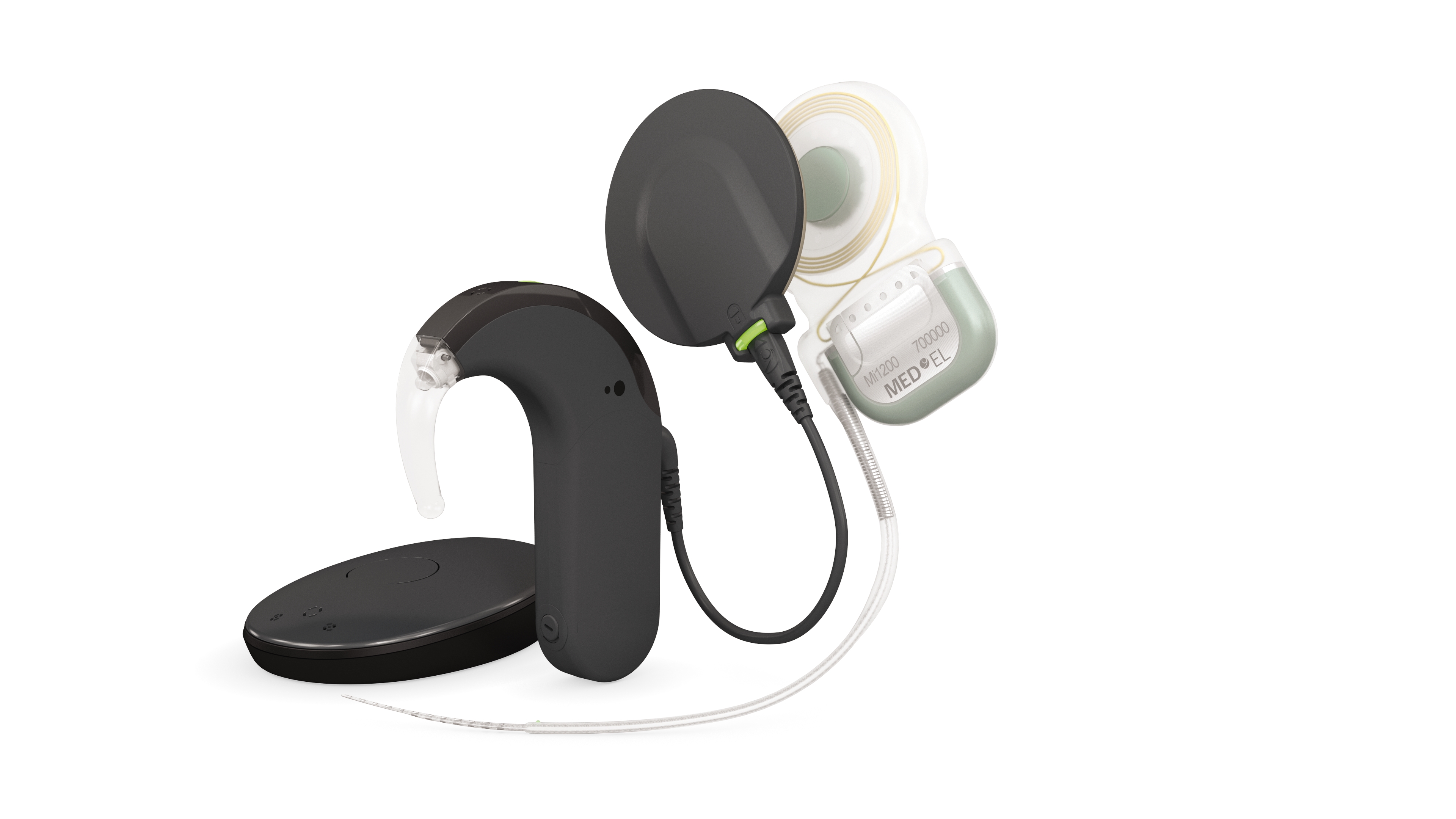Recent FDA-Approval of Cochlear Implants For Single-Sided Deafness and Asymmetric Hearing Loss
AudiologyOnline: Tell us about recently receiving the new FDA approval for cochlear implants for single-sided deafness (SSD) and asymmetric hearing loss (AHL).

Allison Racey: While single-sided deafness and asymmetric hearing loss are relatively new indications within the cochlear implant field, research supporting CI for unilateral hearing loss has been ongoing for a decade. MED-EL initially supported research from Antwerp University Hospital in Belgium aiming to determine whether or not a CI would be beneficial for patients with unilateral hearing loss and severe intractable tinnitus.[i] Researchers realized shortly thereafter that users could also obtain benefits in speech perception and localization from their CI.[ii] MED-EL was able to draw from independent clinical trial data on SSD and AHL, as well as from published literature, to make an argument in support of cochlear implants being safe and effective for use in this population. This marks an unprecedented approval by FDA for MED-EL CI in SSD and AHL.
AudiologyOnline: Define the population of candidates qualifying as single-sided deafness and asymmetric hearing loss.
Allison Racey: First of all, MED-EL is approved for this indication in patients five years of age and older, so both adults and children are able to take advantage of this technology. Single-sided deafness is defined as profound sensorineural hearing loss (SNHL) in the ear to be implanted and normal hearing or mild SNHL in the contralateral ear. Asymmetric hearing loss is defined as profound SNHL in the ear to be implanted and mild to moderately-severe SNHL in the contralateral ear. Someone with profound hearing loss has a four-frequency pure-tone average (PTA) of 90 dB or greater at 500, 1000, 2000, and 4000 Hz. Someone with normal or mild SNHL has a PTA of 30 dB or less in the contralateral ear, and someone with mild to moderately-severe SNHL has a PTA of 31 to 55 dB in the contralateral ear. All candidates must have limited benefit from appropriate amplification, indicated by a monosyllabic word score of 5% or less, and experience with a CROS aid or other relevant device. Additionally, candidates must have a functional auditory nerve and a duration of profound deafness of 10 years or less.
AudiologyOnline: What is different about these candidates versus traditional cochlear implant candidates with the MED-EL system?
Allison Racey: CI candidates with unilateral hearing loss primarily differ from candidates with bilateral hearing loss in that they have one ear that functions at a normal or near-normal level and can mask some of the impact of hearing loss. Candidates with SSD or AHL likely hear well in quiet and one-on-one or small group conversations. However, in large, noisy environments, candidates likely have poor speech perception ability. Unilateral hearing loss can also be a challenge for safety reasons, in that it is difficult to tell from where sounds originate. It may require additional effort for someone with SSD or AHL to participate in conversations in difficult listening environments.
AudiologyOnline: How did MED-EL gain approval for SSD and AHL without conducting a multi-center clinical trial in the United States?
Allison Racey: Data from a clinical trial conducted at the University of North Carolina at Chapel Hill was included in this submission. Speech perception, localization, and quality of life outcomes were reported on 20 SSD and 17 AHL subjects. Additionally, confirmatory evidence from studies conducted at the House Clinic, Antwerp University Hospital, and the University of Western Australia was submitted. Published literature was reviewed for supporting data, and results on children and adults with SSD and AHL were also included. The total body of evidence submitted to FDA was sufficient to demonstrate that CI is effective and safe for use in patients with SSD and AHL.

AudiologyOnline: What can you tell us about the UNC study and its results?
Allison Racey: The researchers at UNC, led by Meg Dillon, demonstrated significant improvements after cochlear implantation in both the SSD and AHL groups. Both groups showed improvements in speech perception in quiet in the ear alone, with average scores increasing by 51 and 50 percentage points on CNC words in quiet, respectively. UNC also conducted testing in speech and noise to demonstrate whether CI recipients are able to take advantage of binaural hearing. Subjects demonstrated improvements in both groups, both when speech and noise were presented to the front of the listener and when speech was presented to the front and noise was presented to the side of the better hearing ear.
AudiologyOnline: It sounds complicated to test SSD and AHL patients in this manner.
Allison Racey: While this more complex testing is necessary to help research the topic and clearly understand what benefits users realize, candidacy testing at a clinic does not have to be so complicated. For candidacy, patients should have less than 5% speech understanding in the profound ear for monosyllabic words, and hearing thresholds that fall in the candidacy range. While it’s interesting to evaluate the results using a complex presentation setup, it isn’t necessary for typical clinical assessment of candidacy.
AudiologyOnline: What did post-operative testing in noise show?
Allison Racey: We often see three conditions tested: speech and noise from the front (S0N0), speech from the front and noise to the CI ear (S0Nci), and speech from the front and noise to the better hearing ear (S0Ncontra). In the S0N0 condition, the data did show small improvements for both groups, nine percentage points for the SSD group and 11 percentage points in the AHL group. No change was demonstrated between pre- and post-operative performance in the S0Nci condition, which is to be expected because of excellent pre-operative performance. What this does tell us is that even when noise is presented to the cochlear implant, this does not have a negative impact on the user’s ability to understand speech presented from the front. In the hardest pre-operative condition, S0Ncontra, a significant improvement was found for both groups, with the cochlear implant improving speech perception by 36 percentage points in the SSD group and 23 percentage points in the AHL group.
AudiologyOnline: You mentioned localization ability, what did the study results show us about users’ ability to localize sound?
Allison Racey: Both groups demonstrated an improvement in sound localization ability as early as one-month post-operatively. These improvements were maintained and some users continued to improve through the 12-month follow-up visit. This was tested by putting recipients in the sound booth on front of an 11-speaker array and asking them to indicate from which speaker they perceived the sound to originate.
AudiologyOnline: Did the study evaluate quality of life in these candidates?
Allison Racey: Yes, the researchers evaluated subjective benefit from the device based on the Abbreviated Profile of Hearing Aid Benefit and Speech, Spatial, and Qualities of Hearing Scale. What they found is that users reported improvement in speech perception, especially in background noise, as well as an improvement in spatial awareness and localization ability, confirming the test results mentioned above. Recipients also noted that they felt less fatigued and less stressed after receiving their cochlear implant and that they were better able to participate in social situations. These results confirm the auditory testing results previously discussed, and also serve to indicate that although these candidates may have an ear with normal or near-normal hearing, quality of life can be positively impacted through cochlear implantation.
AudiologyOnline: How can audiologists get more information about CI and SSD or AHL?
Allison Racey: If you’re interested in learning more about the results discussed here, this data has been published. Two manuscripts are available, one focusing on binaural hearing[iii] and one on quality of life.[iv]
References
[i]Van de Heyning P, et al. Incapacitating unilateral tinnitus in single-sided deafness treated by cochlear implantation. Ann Otol Rhinol Laryngol2008;117(9):645-52.
[ii]Vermeire K, Van de Heyning P. Binaural hearing after cochlear implantation in subjects with unilateral sensorineural deafness and tinnitus. Audiol Neurotol2009;14(3):163-71.
[iii]Buss E, et al. Effects of Cochlear Implantation on Binaural Hearing in Adults with Unilateral Hearing Loss. Trends in Hearing 2018;22:1-15.
[iv]Dillon MT, et al. Effect of Cochlear Implantation on Quality of Life in Adults with Unilateral Hearing Loss. Audiol Neurotol2017;22:259-71.


